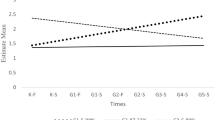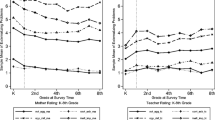Abstract
The aim of this study was to examine growth trajectories of externalizing and internalizing problems during adolescence. In addition, we also examined factors that might account for individual differences in the level of problem behavior and in the rate of change: Adolescent gender and the quality of the relationships with parents and peers. The sample consisted of 212 adolescents (mean age 13.4 years at the initial assessment) who were assessed at 3 measurement waves with approximately 1-year intervals. The results showed substantial absolute and relative stability in both types of problem behavior, but also significant individual differences in both initial levels of problem behavior and in the rate of change across the 3 measurement occasions. Adolescent gender and the quality of the parent–adolescent relationship predicted the initial level of both externalizing and internalizing problems. The protective effect of the positive quality of the relationship with peers was found for internalizing but not for externalizing problems. No differences appeared between boys and girls in the effect of the quality of interpersonal relations on the level and on the rate of change in problem behavior, suggesting that the etiology of problem behavior might be similar for boys and girls in spite of gender differences in the prevalence of problem behaviors.
Similar content being viewed by others
REFERENCES
Achenbach, T. M. (1991). Integrative Guide for the 1991 CBCL/4-8, YSR, and TRF Profiles. University of Vermont, Department of Psychiatry, Burlington, IA.
Alder, A. G., and Scher, S. J. (1994). Using growth curve analyses to assess personality change and stability in adulthood. In Heatherton, T. F., and Weinberger, J. L. (eds.), Can Personality Change? American Psychological Association, Washington, DC, pp. 149–173.
Armsden, G. C., and Greenberg, M. T. (1987). The Inventory of parent and peer attachment: Individual differences and their relationship to psychological well-being in adolescence. J. Youth Adolesc. 16: 427–453.
Bentler, P. M. (1990). Comparative fit indexes in structural models. Psychol. Bull. 107: 238–246.
Berndt, T. J. (1990). Distinctive features and effects of early adolescent friendschips. In Montemayor, R., Adams, G. R., and Gullotta, T. P. (eds.), Advances in Adolescent Dvelopment. Vol. 2. From Childhood to Adolescence. Sage, Newbury Park, CA, pp. 85–106.
Brendgen, M., Vitaro, F., and Bukowski, W. M. (2000). Deviant friends and early adolescents' emotional and behavioral adjustment. J. Res. Adolesc. 10: 173–189.
Bronfenbrenner, U. (1986). Ecology of the family as a context for human development: Research perspectives. Dev. Psychol. 22: 723–742.
Browne, M. W., and Cudeck, R. (1993). Alternative ways of assessing model fit. In Bollen, K., and Long, S. (eds.), Testing Structural Equation Models. Sage, Beverly Hills, CA, pp. 136–162.
Caspi, A., and Moffit, T. (1995). The continuity of maladaptive behavior: From description to understanding in the study of antisocial behavior. In Cicchetti, D., and Cohen, D. J. (eds.), Developmental Psychology. Vol. 2: Risk, Disorder, and Adaptation. Wiley, New York, pp. 472–511.
Charman, T. (1994). The stability of depressed mood in young adolescents: A school-based survey. J. Affect. Disord. 30: 109–116.
Ciccheti, D., and Toth, S. L. (1998). The development of depression in children and adolescents. Am. Psychol. 53: 221–241.
Claes, M., and Simard, R. (1992). Friendship characteristics of delinquent adolescents. Int. J. Adolesc. Youth 3: 287–301.
Dadds, M. R. (1987). Families and the origins of child behavior problems. Fam. Process 26: 341–357.
Darling, N., and Steinberg, L. (1993). Parenting style as context: An integrative model. Psychol. Bull. 113: 487–496.
Deater-Deckard, K., Dodge, K. A., Bates, J. E., and Pettit, G. S. (1998). Multiple risk factors in the development of externalizing behavior problems: Group and individual differences. Dev. Psychopathol. 10: 469–493.
Deković, M. (1999). Risk and protective factors in the development of problem behavior during adolescence. J. Youth Adolesc. 28: 667–685.
Deković, M., and Meeus, W. (1997). Peer relations in adolescence: Effects of parenting and adolescent's self-concept. J. Adolesc. 20: 163–176.
Devine, D., Kempton, T., and Forehand, R. (1994). Adolescent depressed mood and young adult functioning: A longitudinal study. J. Abnorm. Child Psychol. 22: 629–641.
Dishion, T. J., French, D. C., and Patterson, G. P. (1995). The development and ecology of antisocial behavior. In Ciccetti, D., and Cohen, D. C. (eds.), Developmental Psychopathology. Vol. 2: Risk, Disorder, and Adaptation. Wiley, New York, pp. 421–471.
Dishion, T. J., Patterson, G. R., Stoolmiller, M., and Skinner, M. L. (1991). Family, school, and behavioral antecedents to early adolescent involvement with antisocial peers. Dev. Psychol. 27: 172–180.
Duggal, S., Carlson, E. A., Sroufe, L. A., and Egeland, B. (2001). Depressive symptomatology in childhood and adolescence. Dev. Psychopathol. 13: 143–164.
Duncan, T. E., Duncan, S. C., Strycker, L. A., Li, F., and Alpert, A. (1999). An Introduction to Latent Variable Growth Curve Modeling. Concepts, Issues, and Applications. Erlbaum, London.
Elder, G. H. (1980). Family Structure and Socialization. Arno, New York.
Farrell, A. D. (1994). Structural equation modeling with longitudinal data: Strategies for examining group differences and reciprocal relationships. J. Consult. Clin. Psychol. 62: 477–487.
Ge, X., Best, K. M., Conger, R. D., and Simons, R. L. (1996). Parenting behaviors and the occurrence and co-occurrence of adolescent depressive symptoms and conduct problems. Dev. Psychol. 32: 717–731.
Gesac, V., and Schwalbe, M. L. (1986). Parental behavior and adolescent self-esteem. J. Marriage Fam. 48: 37–46.
Harrington, R. (1993). Depressive Disorder in Childhood and Adolescence. Wiley, Chichester, England.
Harter, S., and Whitesell, N. R. (1996). Multiple pathways to self-reported depression and psychological adjustment among adolescents. Dev. Psychopathol. 8: 761–777.
Hartup, W. W. (1979). The social worlds of childhood. Am. Psychol. 34: 944–950.
Hetherington, E. M., and Clingempeel, W. G. (1992). Coping with marital transitions. Monographs of the Society for Research in Child Development, 57: (2–3, Serial No. 27).
Holsen, I., Kraft, P., and Vittersø, J. (2000). Stability in depressed mood in adolescence: Results from a 6-year longitudinal panel study. J. Youth Adolesc. 29: 61–78.
Jacobson, K. C., and Rowe, D. C. (1999). Genetic and environmental influences on the relationships between family connectedness, school connectedness, and adolescent depressed mood: Sex differences. Dev. Psychol. 35: 926–939.
Jöreskog, K. G., and Sörbom, D. (1993). LISREL 8: User's Guide. Scientific Software, Chicago.
Kandel, D. B., and Davies, M. (1982). Epidemiology of depressive mood in adolescents. Arch. Gen. Psychiatry 39: 1205–1212.
Kerr, M., and Stattin, H. (2000). What parents know, how they know it, and several forms of adolescent adjustment: Further support for a reinterpretation of monitoring. Dev. Psychol. 36: 366–380.
L'Abate, L. (1998). Family Psychopathology. The Relational Roots of Dysfunctional Behavior. Guilford, New York.
Laible, D. J., Carlo, G., and Raffaelli, M. (2000). The differential relations of parent and peer attachment to adolescent adjustment. J. Youth Adolesc. 29: 45–59.
Leadbeater, B. J., Kuperminc, G. P., Blatt, S. J., and Hertzog, C. (1999). A multivariate model of gender differences in adolescents' internalizing and externalizing problems. Dev. Psychol. 35: 1268–1282.
Le Blanc, M., Côté, G., and Loeber, R. (1991). Temporal paths in delinquency: Stability, regression, and progression analyzed with panel data from an adolescent and delinquent male sample. Can. J. Criminol. 33: 23–44.
Leone, P. E. (ed.) (1990). Understanding Troubled and Troubling Youth. Sage, Newbury park, CA, pp. 194–225.
Lewinsohn, P. M., Roberts, R. E., Seeley, J. R., Rohde, P., Gotlib, I. H., and Hops, H. (1994). Adolescent psychopathology II: Psychosocial risk factors for depression. J. Abnorm. Psychol. 103: 302–315.
Loeber, R. (1982). The stability of antisocial and delinquent child behavior: A review. Child Dev. 53: 1431–1446.
Loeber, R. (1990). Development and risk factors of juvenile antisocial behavior and delinquency. Clin. Psychol. Rev. 10: 1–41.
Loeber, R., Drinkwater, M., Yin, Y., Anderson, S. J., Schmidt, L. C., and Craford, A. (2000). Stability of family interaction from ages 6 to 18. J. Abnorm. Child Psychol. 28: 353–369.
Loeber, R., and Stouthamer-Loeber, M. (1998). Development of juvenile aggression and violence: Some common misconceptions and controversies. Am. Psychol. 53: 242–259.
Marcus, R. F., and Betzer, P. D. S. (1996). Attachment and antisocial behavior in early adolescence. J. Early Adolesc. 16: 229–249.
Masten, A. S., and Curtis, W. J. (2000). Integrating competence and psychopathology: Pathways toward a comprehensive science of adaptation in develoment. Dev. Psychopathol. 12: 529–550.
McArdle, J. J., and Epstein, D. (1987). Latent growth curves within developmental structural models. Child Dev. 58: 110–133.
McCord, J. (1990). Problem behaviors. In Feldman, S. S., and Elliott, G. R. (eds.), At the Threshold: The Developing Adolescent. Harvard University Press, Cambridge, MA, pp. 414–430.
Meredith, W., and Tisak, J. (1990). Latent curve analysis. Psychometrika 55: 107–122.
Moffit, T. (1993). Adolescence-limited and life-course-persistent antisocial behavior: A developmental taxonomy. Psychol. Rev. 100: 674–701.
Mounts, N. S. (2002). Parental management of adolescent peer relations in context: The role of parenting style. J. Fam. Psychol. 16: 58–69.
Nada Raja, S., McGee, R., and Stanton, W. R. (1992). Perceived attachments to parents and peers and psychological well-being in adolescence. J. Youth Adolesc. 21: 471–485.
Nagin, D. S. (1999). Analyzing developmental trajectories: A semiparametric, group-based approach. Psychol. Methods 4: 139–157.
Nagin, D., and Tremblay, R. E. (1999). Trajectories of boys' physical aggression, opposition, and hyperactivity on the path to physically violent and nonviolent juvenile delinquency. Child Dev. 70: 1181–1196.
Nolen-Hoeksema, S., and Girgus, J. S. (1994). The emergence of gender differences in depression during adolescence. Psychol. Bull. 115: 424–443.
O'Donell, J., Hawkins, J. D., and Abbott, R. D. (1995). Predicting serious delinquency and substance use among aggressive boys. J. Consult. Clin. Psychol. 63: 529–537.
Patterson, G. R. (1993). Orderly change in stable world: The antisocial trait as a chimera. J. Consult. Clin. Psychol. 61: 911–919.
Patterson, G. R., Reid, J. B., and Dishion, T. J. (1992). Antisocial Boys: A Social Interactional Approach. Castalia, Eugene, OR.
Petersen, A. C., Compas, B. E., Books-Gunn, J., Stemmler, M., Ey, S., and Grant, K. E. (1993). Depression in adolescence. Am. Psychol. 48: 155–168.
Pike, A., McGuire, S., Hetherington, E. M., Reiss, D., and Plomin, R. (1996). Family environment and adolescent depressive symptoms and antisocial behavior: A multivariate genetic analysis. Dev. Psychol. 32: 590–603.
Resnick, G., and Burt, M. R. (1996). Youth at risk: Definitions and implications for service delivery. Am. J. Orthopsychiatry 66: 172–188.
Scaramella, L. V., Conger, R. D., and Simons, R. L. (1999). Parental protective influences and gender-specific increases in adolescent internalizing and externalizing problems. J. Res. Adolesc. 9: 111–141.
Snyder, J., and Huntley, D. (1990). Troubled families and troubled youth. The development of antisocial behavior and depression in children. In Leone, P. E. (ed.), Understanding Troubled and Troubling Youth. Sage, Newbury Park, CA, pp. 194–225.
Steinberg, L., Lamborn, S. D., Dornbusch, S. M., and Darling, N. (1992). Impact of parenting practices on adolescent achievement: Authoritative parenting, school involvement, and encouragement to succeed. Child Dev. 63: 1266–1281.
Stoolmiller, M. (1994). Antisocial behavior, delinquent peer association, and unsupervised wandering for boys: Growth and change from childhood to early adolescence. Multivariate Behav. Res. 29: 263–288.
Tremblay, R. E., Loeber, R., Gagnon, C., Charlebois, P., Larivee, S., and La Blanc, M. (1991). Disruptive boys with stable and unstable high fighting behavior patterns during junior elementary school. J. Abnorm. Child Psychol. 19: 285–300.
Verhulst, F. C., Ende, J. van der, and Koot, H. M. (1996). Handleiding voor de CBCL/4-18 [Manual for the CBCL/4-18]. Erasmus University, Rotterdam, The Netherlands.
Willet, J. B., Ayoub, C. C., and Robinson, D. (1991). Using growth modeling to examine systematic differences in growth: An example of change in the functioning of families at risk of maladaptive parenting, child abuse, or neglect. J. Consult. Clin. Psychol. 59: 38–47.
Willet, J. B., and Sayer, A. G. (1994). Using covariance structure analysis to detect correlates and predictors of individual change over time. Psychol. Bull. 116: 363–381.
Willett, J. B., Singer, J. D., and Martin, N. C. (1998). The design and analysis of longitudinal studies of development and psychopathology in context: Statistical models and methodological recommendations. Dev. Psychopathol. 10: 395–426.
Zahn-Waxler, C. (1993). Warriors and worriers: Gender and psychopathology. Dev. Psychopathol. 5: 79–90.
Author information
Authors and Affiliations
Rights and permissions
About this article
Cite this article
Deković, M., Buist, K.L. & Reitz, E. Stability and Changes in Problem Behavior During Adolescence: Latent Growth Analysis. Journal of Youth and Adolescence 33, 1–12 (2004). https://doi.org/10.1023/A:1027305312204
Issue Date:
DOI: https://doi.org/10.1023/A:1027305312204




